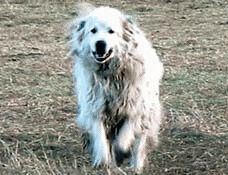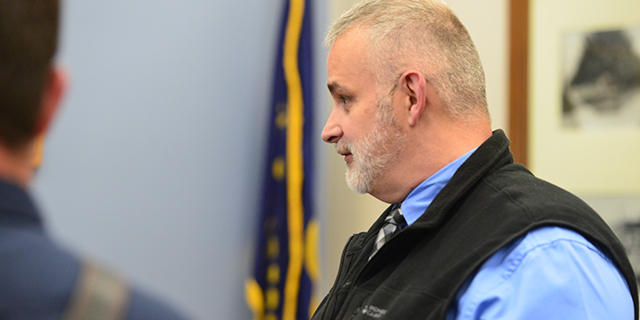TO SERVE AND PROTECT
Published 12:00 am Saturday, March 10, 2007

- ON GUARD: It seems 8-year-old C.B. rarely holds still as he divides his time between running the perimeter, mingling with the flock, watching over ewes seeking solitude to lamb and checking out strangers. (The Observer/MARDI FORD).
– Mardi Ford
Trending
– The Observer
Ron Dake tells the story about a working dog he once had named Grizzly Bear. It goes something like this.
Many years ago, Ron and his wife Nancy, of the Summerville area, were running sheep up on Pumpkin Ridge. Grizzly Bear a big Yugoslavian breed known as Shar Planinetz or Sarplaninac was new to the operation. Bred as a working dog, Grizzly Bear’s entire purpose at sheep camp was to protect the sheep from predators.
Trending
He failed his first test miserably.
"I saw the sheep down in a little draw by itself and I thought it was asleep. When I got closer, I could see it was dead. The rest of the sheep were up in a stand of trees, and that dog was nowhere around he was back at sheep camp," Ron says indignantly, his voice raising as he gets into the story.
Ron hauled the dog back to where the dead sheep lay and rubbed Grizzly Bear’s nose in it literally and figuratively. What followed next, Ron says, was amazing.
The big dog sniffed around for a minute, then ran after the sheep driving them back out of the trees. Ron had no clue what the dog was doing by then having some serious doubts about its sanity.
But once the sheep had safely cleared the trees, Grizzly Bear dashed back into them and disappeared. Before long he had returned parts of the dead coyote hanging from his mouth.
"He flung it at my feet, like, ‘There!’ and trotted off," Ron says with a grin. "He never left those sheep again."
As he finishes the story, his eyes shine with all the pride of a new father. "He only had to be shown once, and he knew exactly what to do."
Ron and Nancy have many stories of the livestock guard dogs of various breeds that have worked side by side with them during their years in sheep ranching.
"They’re our heroes," Ron says simply.
For centuries, across Europe and Asia men have used special breeds of dogs as livestock guardians. The Yugoslavian breed like Grizzly Bear, the Dakes say, are no longer as prevalent in the United States as they once were, although their skills and natural instincts are unsurpassed for predator control.
"Breed looks too much like a wolf," Ron suggests.
Some of the more popular breeds used here in the U.S. include the Anatolian shepherd dog, a Turkish breed reportedly more than 6,000 years old. The Akbash breed is another found in rural Turkey and is believed to have been serving as a livestock protection dog for millennia.
The Maremma is an Italian breed directly descended from the first flock guarders may have migrated across the Adriatic from Greece.
And the Komondor is an Hungarian guard dog descended from dogs of the Russian steppes. It has the white, corded coat that gives him the unique appearance of sporting dreadlocks and is most often recognized as a "sheep dog."
Last but not least, is the Great Pyrenees, from France. This dog is descended from the Hungarian Kuvasz and the Maremmano-Abruzzese. It is considered the aristocratic relative of the St. Bernard and Newfoundland. It is the breed the Dakes use today.
They currently have three Great Pyrenees Puff, a 14 -year-old female whose guarding days are winding down, C.B. (Cinnamon Bear) an 8-year-old male who is top dog right now, and President, an almost 3-month-old male who is just learning his place. He will someday replace Puff, who adores him. C.B., on the other hand, has little time for a new dog.
Surrounded by sheep, President is learning to bond with them. The Dakes purposely don’t spend much time with their new pup at this stage.
"You don’t want them to be afraid of you, either, because you have to be able to get ahold of them if you need to doctor them or take them somewhere. We just try to keep the contact to a minimum at first," Ron says.
The biggest drawback to these bundles of cuddly puppy fur is that most folks who don’t realize what they are bred for have a natural inclination to make pets out of them.
Nancy tells another story about a new Akbash-Pyrenees pup they bought a few years back. The new pup had been transported as far as Kennewick, but Nancy was unable to pick it up right away. By the time she got there a week later, the woman who had agreed to hold the dog had already made a pet out of it.
"When we put Doc in with the sheep, he didn’t want to stay. We tried everything to keep that pup in the barn long enough to allow the natural instincts to (bond with the sheep) kick in, but nothing worked," Nancy says.
Instead, the dog wanted to live at the house and play with the sheep and chew on them. Doc would also leave the flock and run over to play with the neighbor kids who naturally loved it. But the animal had been ruined as a guard dog and the Dakes ended up having to find another home for him.
So President’s place is with the bummer lambs in a big old barn that houses new mamas and their babies, as well. Though already much bigger and heavier than the bummers he keeps company with, President seems shy and timid around the sheep.
She refers to a theory by Raymond Coppinger, an authority on canine behavior, who has been a biology professor at Hampshire College more than 30 years. She opens an article from Smithsonian Magazine Coppinger authored on how the shapes of different breeds’ ears are an indicator of aggressiveness or submissiveness.
Newborn puppies, Coppinger writes, have floppy ears folded over towards the front. Interestingly, as the different breeds he compares in the article mature, the only ones whose ears remain the same floppy, puppy ears are livestock guard dogs.
However, this puppyhood submissiveness to the sheep they protect does not impact the guard dog’s reaction to predators. Sometimes, just having one around is enough to discourage Wily Coyote. Nancy recalls a Coppinger quote from a lecture she attended several years ago, as he described the predators’ instincts to avoid a large guard dog in a flock of sheep.
"Coppinger said, ‘You don’t have to step into the ring with (Mohammed) Ali to know you’re no match.’ I’ve never forgotten that," she says.
Nancy also recalls Coppinger talking about how U.S. dog lovers tend to Americanize these ancient breeds to their detriment. Though a centuries-old tradition in Asia and Europe, using livestock guardian dogs for sheep ranching rather than pets is a relatively new one for Americans.
It began, Ron and Nancy remember, when the U.S. Department of Agriculture began the Animal Damage Program in the mid-1980s. In 1986 that program was transferred from the U. S. Fish and Wildlife Service to the Animal and Plant Health Inspection Service of USDA.
"We leased the dogs from them and they monitored how the program worked. It was inexpensive, I think, because they wanted to introduce them and hoped the program would catch on," says Ron.
The dogs, he says, are an invaluable tool in the warfare against predators.
As one ewe wandered off from the flock to give birth to twins in a line of trees that border the property, C.B. divided his time between her and the flock. He had already made several perimeter checks that morning and treed a cat who was getting too close to the lone ewe, Ron says.
"I just watch C.B.," he adds. "I knew we had lambs over there before I even saw the ewe."









